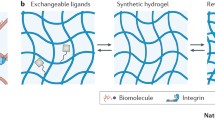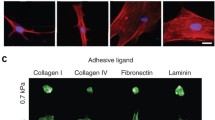Abstract
In vivo, cells can grow in 3D and significantly differ from cells grown in 2D. Imitating an extracellular microenvironment, 3D cell culture platforms using dynamic hydrogels have emerged, which can be altered by external stimuli, such as light, to mimic the chemical and physical properties of the native cellular environment. Photo-sensitive matrices enable the non-invasive, on-demand assembly of proteins and allow them to take influence on cells in real-time with high accuracy.
Similar content being viewed by others
Literatur
LaFratta CN, Fourkas JT, Baldacchini T et al. (2007) Multiphoton fabrication. Angew Chem Int Ed Engl 46:6238–6258
Geiger B, Spatz JP, Bershadsky AD (2009) Environmental sensing through focal adhesions. Nat Rev Mol Cell Biol 10:21–33
Langer R, Tirrell DA (2004) Designing materials for biology and medicine. Nature 428:487–492
Lutolf MP, Hubbell JA (2005) Synthetic biomaterials as instructive extracellular microenvironments for morphogenesis in tissue engineering. Nat Biotechnol 23:47–55
Lata S, Reichel A, Brock R et al. (2005) High-affinity adaptors for switchable recognition of histidine-tagged proteins. J Am Chem Soc 127:10205–10215
Grunwald C, Schulze K, Reichel A et al. (2010) In situ assembly of macromolecular complexes triggered by light. Proc Natl Acad Sci USA 107:6146–6151
Laboria N, Wieneke R, Tampe R (2013) Control of nanomolar interaction and in situ assembly of proteins in four dimensions by light. Angew Chem Int Ed Engl 52:848–853
Lutolf MP, Gilbert PM, Blau HM (2009) Designing materials to direct stem-cell fate. Nature 462:433–441
Author information
Authors and Affiliations
Corresponding author
Additional information
Ralph Wieneke1999–2005 Chemiestudium an der Universität Marburg, 2009 Promotion in bioorganischer Chemie unter der Leitung von Prof. Dr. A. Geyer. 2009 Gastwissenschaftler an der Universität Göttingen im Labor von Prof. Dr. C. Steinem. 2010–2014 Postdoktorand an der Universität Frankfurt a. M. unter der Leitung von Prof. Dr. R. Tampé. Seit 2014 eigenständige Arbeiten auf dem Gebiet der optochemischen Biologie mit Fokus auf der Entwicklung von molekularen Werkzeugen zur Untersuchung und Manipulation von Membran-assoziierten Prozessen.
Rights and permissions
About this article
Cite this article
Wieneke, R. Lichtstrukturierte Matrizen für die räumlich-zeitliche Proteinanordnung. Biospektrum 24, 471–474 (2018). https://doi.org/10.1007/s12268-018-0947-0
Published:
Issue Date:
DOI: https://doi.org/10.1007/s12268-018-0947-0




